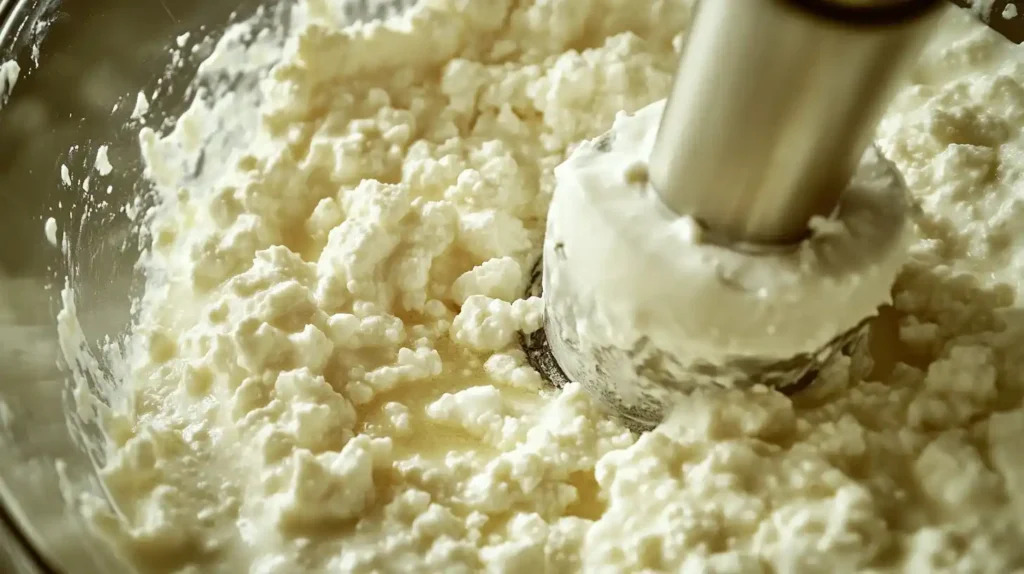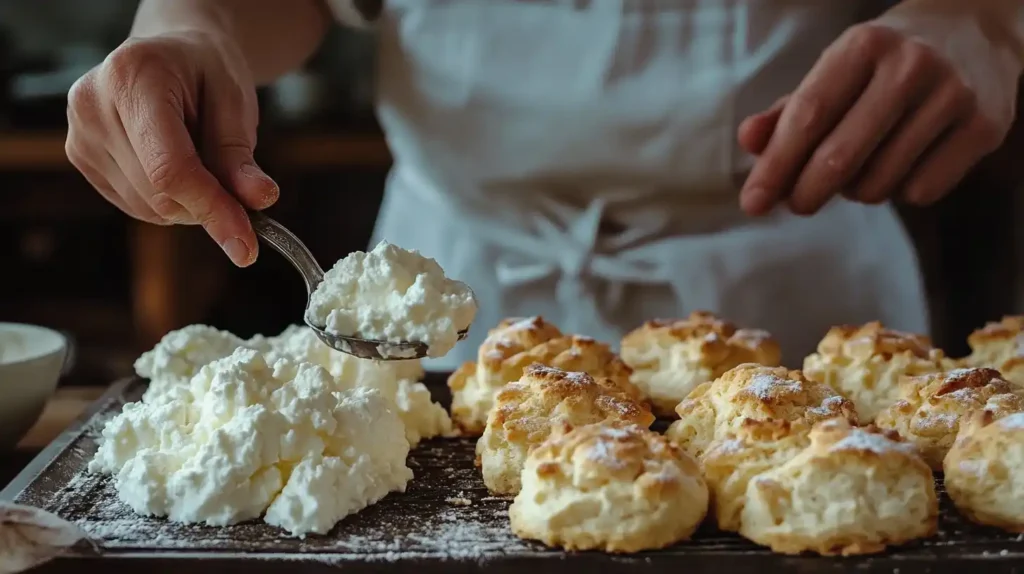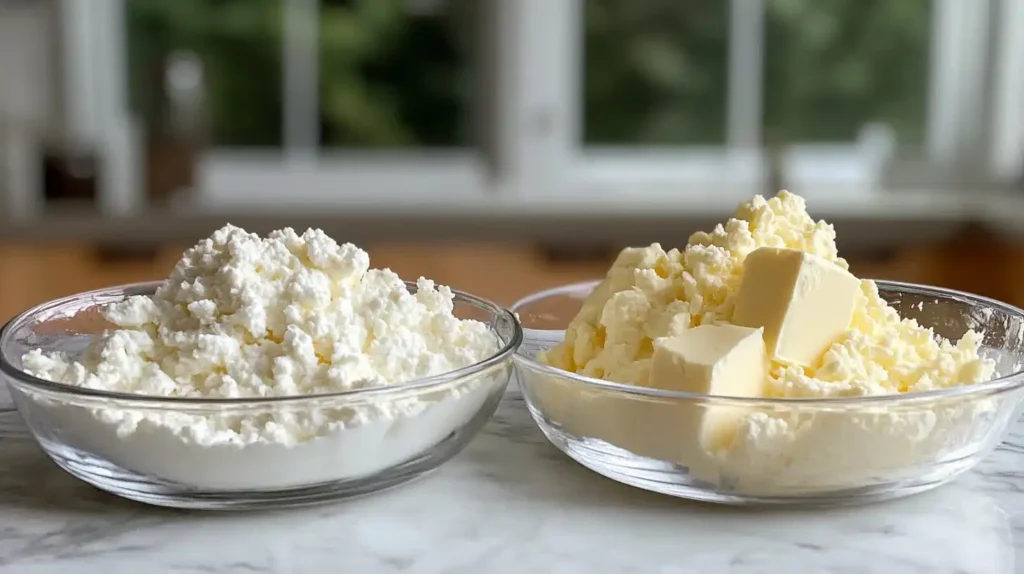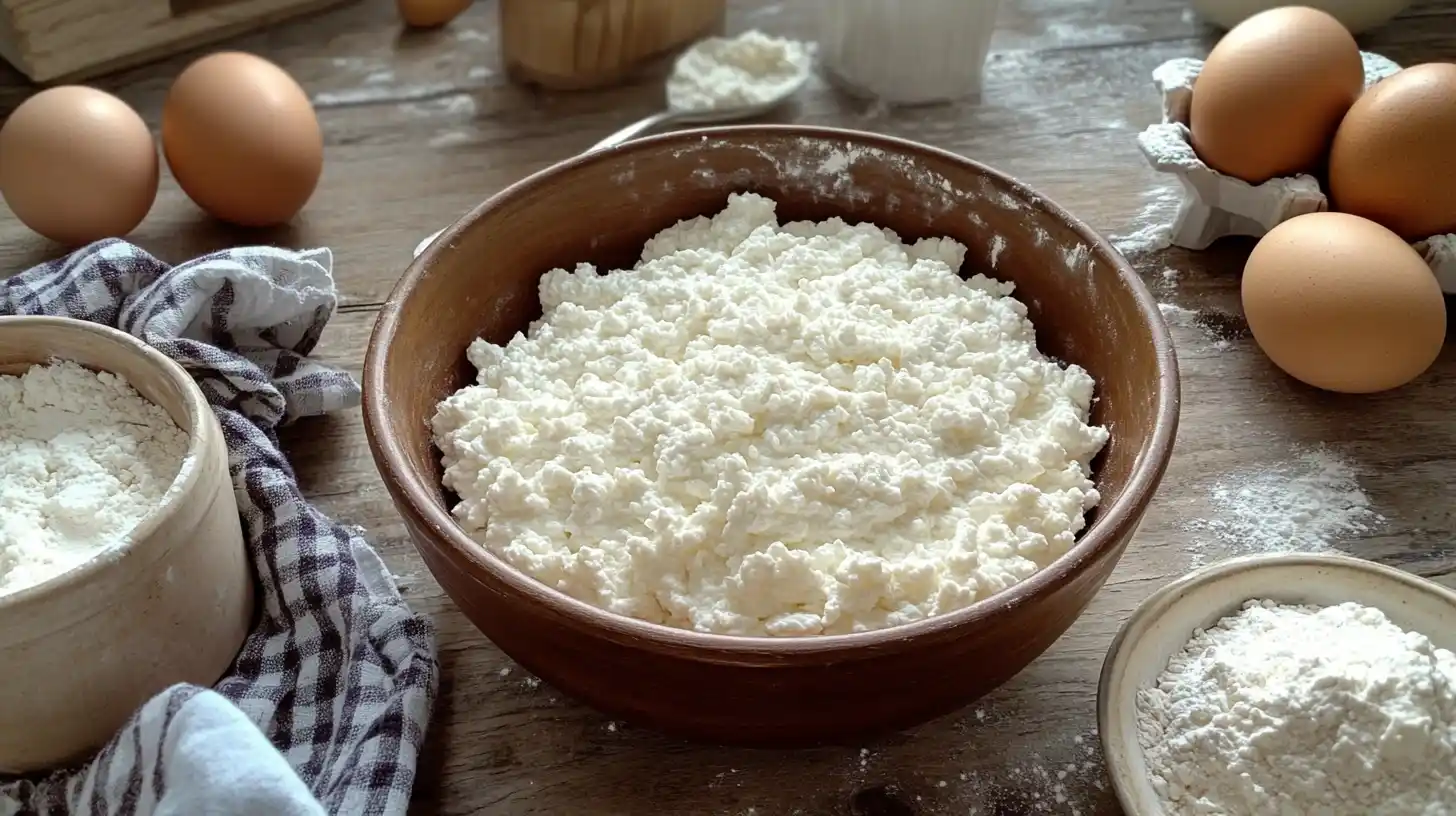Baking with cottage cheese is an excellent way to elevate your recipes. But what does cottage cheese do in baking? It boosts moisture, improves texture, and adds a unique flavor that works perfectly in both sweet and savory dishes. Let’s explore how this ingredient transforms your baked goods!
Table of contents
- What is Cottage Cheese?
- Why Does Cottage Cheese Work in Baking?
- Nutritional Benefits of Cottage Cheese in Baking
- How Cottage Cheese Helps in Baking
- How to Use Cottage Cheese as a Substitute
- Popular Recipes with Cottage Cheese
- Tips for Baking Success with Cottage Cheese
- FAQs About Cottage Cheese in Baking
- Conclusion

What is Cottage Cheese?
Cottage cheese is a soft dairy product made by curdling milk. Its creamy yet slightly chunky texture and low fat content make it ideal for both sweet and savory recipes. For example, if you’re exploring healthier alternatives, it’s a great way to add protein without the extra calories of traditional ingredients like butter or cream cheese. Learn more about other cottage cheese-based recipes in The Ultimate Guide to Making the Perfect Cottage Cheese Bake.
This versatile cheese is packed with nutrients. It’s high in protein, low in calories, and contains essential vitamins like calcium and B12. These qualities make it a favorite among people looking for healthier options in cooking and baking.
What makes cottage cheese special in baking? Its high moisture content and protein-rich nature set it apart. When added to recipes, it helps keep baked goods soft and adds a light, tangy flavor that complements both sweet and savory dishes.
Why Does Cottage Cheese Work in Baking?
Cottage cheese brings unique qualities to baked goods, making it a versatile ingredient. Here’s why it works so well:
- Keeps Things Moist
The high water content in cottage cheese helps keep baked goods moist. This is especially important for recipes like muffins, cakes, and breads, which can dry out easily. - Adds Protein for Structure
The protein in cottage cheese strengthens the structure of your baked goods. This means your cakes and breads hold their shape better while staying light and fluffy. - Enhances Flavor
The mild tang of cottage cheese adds a subtle flavor that pairs beautifully with both sweet and savory recipes. It can balance rich chocolate desserts or add depth to savory bakes like quiches. - Acts as a Binder
In some recipes, cottage cheese can help hold the ingredients together, especially if you’re baking without eggs.
These qualities make cottage cheese a preferred ingredient for bakers seeking improved texture, flavor, and nutrition. Want to know more about how cottage cheese boosts baking? Check out the science of baking with dairy.
Nutritional Benefits of Cottage Cheese in Baking
When it comes to healthy baking, cottage cheese is a superstar. It’s not only packed with nutrients but also helps make your recipes lighter and more wholesome. Here’s why it’s a smart choice:
- High in Protein
Cottage cheese is rich in protein, which supports muscle health and keeps you feeling full. This makes it perfect for protein-packed treats like pancakes or muffins. - Low in Calories and Fat
Unlike butter or cream cheese, cottage cheese has fewer calories and less fat. By using it as a substitute, you can enjoy baked goods that are lower in calories without losing flavor or texture. - Rich in Calcium
Calcium is essential for healthy bones and teeth, and cottage cheese is a great source. Adding it to your recipes can boost your daily intake. - Supports a Balanced Diet
Thanks to its combination of protein, vitamins, and minerals, cottage cheese fits well into balanced, healthy meals.
By swapping heavy ingredients like butter or cream for cottage cheese, you can make your baked goods more nutritious. This ingredient is proof that healthier baking doesn’t mean compromising on taste or quality.

How Cottage Cheese Helps in Baking
When it comes to healthy baking, cottage cheese is a superstar. It’s not only packed with nutrients but also helps make your recipes lighter and more wholesome. Here’s why it’s a smart choice:
- High in Protein
Cottage cheese is rich in protein, which supports muscle health and keeps you feeling full. This makes it perfect for protein-packed treats like pancakes or muffins. - Low in Calories and Fat
Unlike butter or cream cheese, cottage cheese has fewer calories and less fat. By using it as a substitute, you can enjoy baked goods that are lower in calories without losing flavor or texture. - Rich in Calcium
Calcium is essential for healthy bones and teeth, and cottage cheese is a great source. Adding it to your recipes can boost your daily intake. - Supports a Balanced Diet
Thanks to its combination of protein, vitamins, and minerals, cottage cheese fits well into balanced, healthy meals.
By swapping heavy ingredients like butter or cream for cottage cheese, you can make your baked goods more nutritious. This ingredient is proof that healthier baking doesn’t mean compromising on taste or quality.
How to Use Cottage Cheese as a Substitute
One of the most exciting uses for cottage cheese in baking is as a substitute for heavier, calorie-rich ingredients. It’s an easy swap that keeps your recipes light and nutritious while still tasting great. Here’s how you can use it:
- Replacing Butter
- Substitute cottage cheese for half the butter in recipes like cakes and cookies.
- This keeps the texture moist and soft while cutting fat and calories.
- Tip: Blend cottage cheese for a smooth consistency before using it.
- Substituting for Cream Cheese
- Blend cottage cheese until it’s creamy and use it as a 1:1 substitute for cream cheese.
- Ideal for cheesecakes, frostings, or dips.
- It adds a light, tangy flavor without the heaviness of cream cheese.
- Replacing Yogurt or Milk
- Use a 1:1 ratio to swap cottage cheese for yogurt or milk in recipes like pancakes, muffins, or quick breads.
- It provides the same creaminess and keeps baked goods moist.
- Egg Alternative in Some Recipes
- In certain recipes, cottage cheese can act as a binder, especially when eggs aren’t an option.
- Use ¼ cup of blended cottage cheese for each egg being replaced.
Tips for Successful Substitution
- Always blend cottage cheese for recipes requiring a smooth texture.
- Adjust liquids slightly to account for the moisture in cottage cheese.
- Choose full-fat cottage cheese for richer flavor or low-fat for lighter options.
By using cottage cheese as a substitute, you can enjoy lighter, healthier versions of your favorite baked goods without sacrificing taste or quality.

Popular Recipes with Cottage Cheese
If you’re wondering how to use cottage cheese in your baking, the possibilities are endless. Its smooth texture and subtle flavor make it a flexible ingredient for both sweet and savory recipes. Here are some popular recipes where cottage cheese truly shines:
1. Cheesecakes and Pies
Cottage cheese can be the star of desserts like cheesecakes and pies.
- How to Use: Replace cream cheese with blended cottage cheese for a lighter filling.
- Why It Works: It keeps the dessert creamy while cutting fat and calories.
- Try This: Cottage cheese lemon cheesecake for a tangy, refreshing treat.
2. Muffins and Quick Breads
Adding cottage cheese to muffins or breads takes their texture to the next level.
- How to Use: Stir blended or chunky cottage cheese into the batter.
- Why It Works: The moisture content prevents dryness and creates a fluffy texture.
- Try This: Banana muffins with cottage cheese for a protein-packed breakfast.
3. Savory Bakes
Cottage cheese isn’t just for sweets. It works wonders in savory dishes too.
- How to Use: Add it to quiches, frittatas, or even savory scones.
- Why It Works: It enhances creaminess and complements herbs and spices.
- Try This: Spinach and cottage cheese quiche for a hearty meal.
Cottage cheese is a great addition to savory dishes like quiches and seafood-based bakes. If you’re incorporating lobster into your dish, you might be wondering, Are Lobster Claws Already Cooked? Find out before preparing your next seafood-inspired bake!
4. Pancakes and Waffles
Transform your breakfast favorites with cottage cheese.
- How to Use: Mix it directly into the batter for extra fluffiness.
- Why It Works: The protein content adds structure and keeps pancakes light.
- Try This: Protein-packed cottage cheese pancakes topped with fresh fruit.
5. Healthy Cookies and Brownies
Yes, you can make cookies and brownies healthier with cottage cheese!
- How to Use: Replace some butter or cream cheese with blended cottage cheese.
- Why It Works: It keeps baked goods moist and adds a slight tangy flavor.
- Try This: Chocolate chip cookies with cottage cheese for a guilt-free treat.
By incorporating cottage cheese into these recipes, you can enjoy delicious and healthier baked goods. Whether it’s a dessert, breakfast, or savory snack, this ingredient adds a unique twist to your dishes.
Tips for Baking Success with Cottage Cheese
Baking with cottage cheese is simple, but following a few key tips can make your recipes even better. These guidelines will help you achieve the perfect texture and flavor every time.
1. Blend for Smoothness
- For recipes like cheesecakes, frostings, or batters that need a silky texture, blending cottage cheese is essential.
- Use a food processor or blender to eliminate lumps. This ensures the final product is smooth and creamy.
2. Choose the Right Type
- Full-fat Cottage Cheese: Best for rich, indulgent bakes like cheesecakes or brownies.
- Low-fat Cottage Cheese: Ideal for lighter recipes such as pancakes or muffins.
Both types work well, but your choice should match the recipe’s goal.
3. Adjust Liquids
- Because cottage cheese has high moisture content, reduce other liquids slightly to maintain the right batter consistency.
- This is especially important for recipes like quick breads or cookies.
4. Don’t Overuse It
- While cottage cheese is versatile, adding too much can overwhelm the dish. Stick to recommended quantities to keep flavors balanced.
5. Pair with Complementary Flavors
- The mild tang of cottage cheese pairs well with ingredients like:
- Fruits (e.g., bananas, berries, or citrus).
- Spices (e.g., cinnamon, nutmeg, or paprika for savory bakes).
- Herbs (e.g., parsley, chives, or spinach for savory dishes).
Pairing cottage cheese with the right ingredients can enhance its flavor in both sweet and savory recipes. For example, crispy toppings like breadcrumbs or fried onions can add texture. Ever wondered, What Are French Fried Onions Made Of? Learn more about this crunchy favorite here.
6. Experiment with Substitutions
- Replace butter, cream cheese, or yogurt with cottage cheese in small amounts first. Gradually increase as you get familiar with how it affects the recipe.
By following these tips, you can make the most of cottage cheese in your baking. It’s an ingredient that’s easy to work with once you understand its properties.
FAQs About Cottage Cheese in Baking
Here are some common questions people have about using cottage cheese in their baking, along with clear answers to help you bake with confidence.
1. What does cottage cheese replace in baking?
Cottage cheese can replace several ingredients, depending on the recipe:
- Butter: Replace half the butter with cottage cheese for moist, low-fat baked goods.
- Cream Cheese: Use blended cottage cheese as a 1:1 substitute in cheesecakes or frostings.
- Yogurt or Milk: Swap cottage cheese in a 1:1 ratio to add creaminess.
This flexibility makes cottage cheese a versatile ingredient in the kitchen.
2. Can you use cottage cheese instead of cream cheese?
Yes, you can! Blending cottage cheese smooth creates a creamy texture similar to cream cheese. It works well in cheesecakes, dips, and spreads while cutting down on fat and calories.
3. Does cottage cheese make baked goods healthier?
Absolutely. Cottage cheese is lower in fat and calories than traditional baking ingredients like butter or cream. Plus, it’s high in protein and calcium, making your treats more nutritious.
4. Should I use full-fat or low-fat cottage cheese for baking?
It depends on your recipe:
- Full-fat Cottage Cheese: Provides a richer flavor and creamier texture, ideal for indulgent desserts.
- Low-fat Cottage Cheese: Great for lighter recipes like muffins or pancakes.
5. How do I blend cottage cheese for baking?
To blend cottage cheese, use:
- A blender or food processor for a creamy, lump-free texture.
- Add a small amount of liquid like milk or yogurt if needed to help blend smoothly.
6. What’s the difference between using blended and chunky cottage cheese?
- Blended Cottage Cheese: Best for smooth batters or creamy fillings, like cheesecakes.
- Chunky Cottage Cheese: Works well in recipes where texture is less critical, like quiches or muffins.
By understanding these answers, you can confidently use cottage cheese in your recipes to create delicious and healthier baked goods.
Conclusion
Baking with cottage cheese is a fantastic way to improve your recipes. It adds moisture, boosts texture, and enhances flavor while keeping baked goods healthier. Whether you’re looking to make a rich cheesecake, fluffy muffins, or savory quiches, cottage cheese can take your baking to the next level.
Its versatility makes it a smart substitute for butter, cream cheese, or milk, offering a lighter, protein-packed alternative. Plus, with the right tips like blending for smoothness and adjusting liquids you’ll have no trouble creating perfect treats every time.
So, why not give cottage cheese a try in your next baking project?It’s a small adjustment that can have a significant impact. Start experimenting today and discover how this humble ingredient can transform your favorite recipes.

